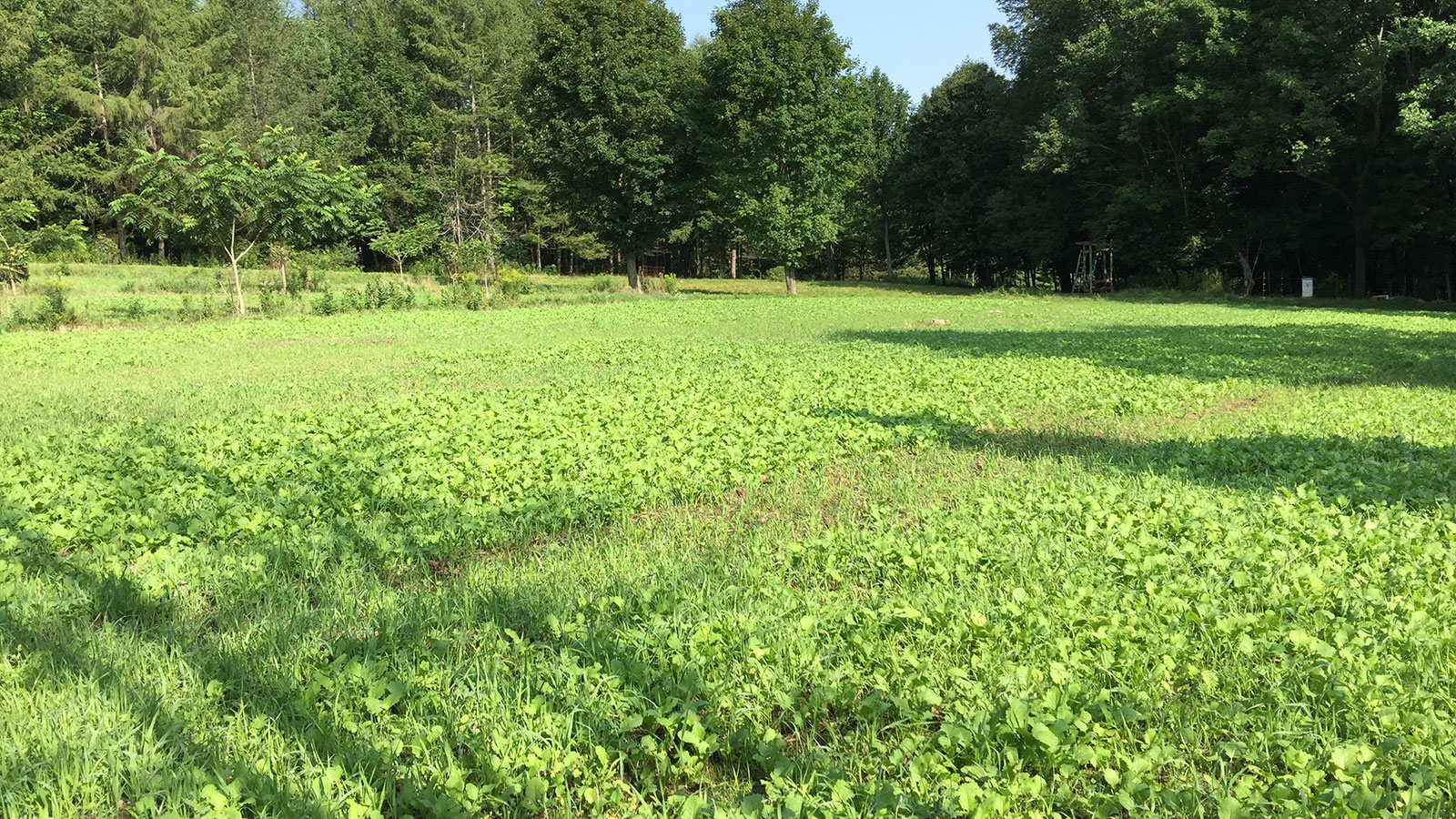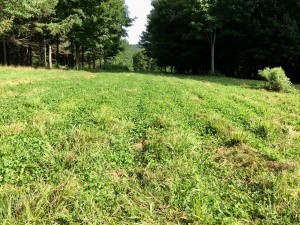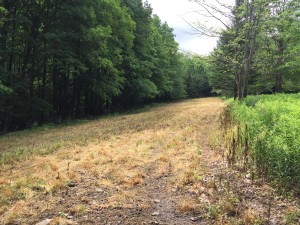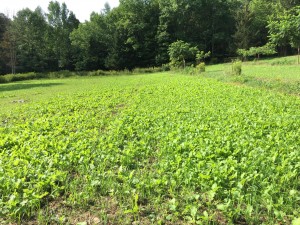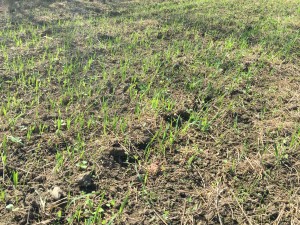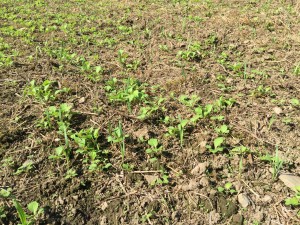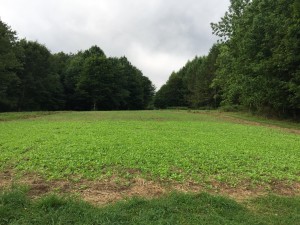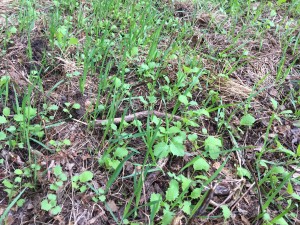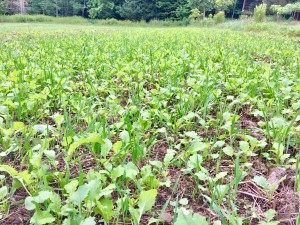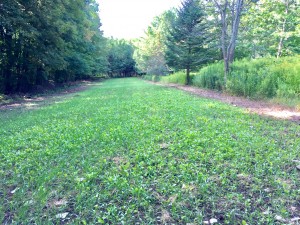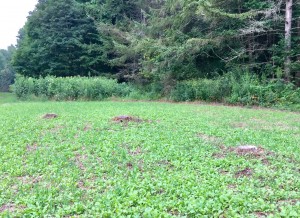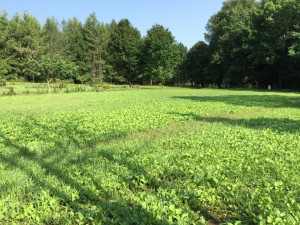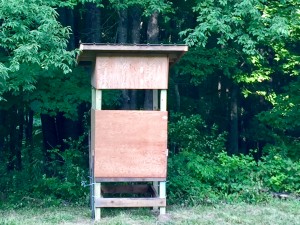We haven’t planted new food plots since 2014 and it is time (Summer 2017) to plant some fall annual food plots in preparation for perennial food plots in 2018. We have a half acre of three year old Imperial Whitetail™ Brand Clover which needs to replaced in 2018 with at least an acre of Whitetail Clover. This late summer (August 5th) we planted six seed mixes from the Whitetail Institute. We have found reliability and innovation with Whitetail Institute products and seldom try other brands. Seed selection is one of the most important aspects of planting food plots. This time we are planting Pure Attraction®, Ambush®, Winter Greens™, Beets & Greens™, Tall Tine Tubers™ and Imperial Whitetail Oats Plus™. These are all annual seed blends and should be killed during the winter in this western New York location.
We started in June preparing for this planting with a late burn down. I say late because of very rainy spring weather. We did not apply the first application of glyphosate until the weeds were about 18 inches tall in most places. We used a heavy rate of glyphosate to control perennial weeds, with quackgrass being our biggest concern. We made a second application about the third week of July. To attempt to control quackgrass, you must make a second application when it re-grows following the first application. Since we are planting fall annual food plots, we will have another opportunity to control the quackgrass, if it regrows. We will make another burn down application next spring, before we plant our perennial planting of Whitetail Clover.
When we look at food plot seed blends in advertising and online, we get an idea of what is in the package, but to know exactly what is in the package you must read the Seed Label on the package you purchase. The seed label is required by the USDA (United States Department of Agriculture). This label will tell you the specific varieties, percent pure seed, germination percentage, origin of the seed (state), percent weed seed, percent inert matter, germination test date, amount of noxious weeds, container weight, etc.
Here is the seed label information for the varieties in the seed bags we purchased: These seed mixes contain a high percentage of coating material which is very important to the germination and weight distribution of the seed as it goes out a broadcast seed spreader. It is better to ensure that the seed you plant will grow than to purchase uncoated seed that may not germinate in adverse conditions. The coating is All-Vantage containing RainBond which will also helps water adhere to the seed in dry conditions.
Tall Tine Tubers: We like Tall Tine Tubers which we have grown before. The turnips provide foliage for the deer to eat after a freeze in the fall and the turnip “bulbs” to eat throughout the winter and early spring.
Tall Tine Turnip – 55.24%
Purple Top Turnip – 10.48%
Other Crop – 0%
Weed Seed – 0.05%
Inert Matter (includes 34.18% Coating Material)
Beets & Greens: This is the first time we have planted this seed mix. We are excited to see how the sugar beets in this mix preform. We have grown the other plants in the mix previously including Radish, Kale, Rape, and Tall Tine Turnips. It appears to be a mix that will nourish deer in late fall and possibly through winter and early spring. We had difficulty calibrating our hand held seeder to spread this seed because of the size difference between the larger beet seed and the smaller brassica/turnip seed. When we opened the seeder up to accommodate the beet seed, it let out too many brassicas. We feel this was the cause of our planting too much seed on a smaller area than the 1/2 acre intended. We may need to look at other seeder options.
WINA 412 Radish – 25.59%
WINA 210 Kale – 18.87%
Trophy Rape – 18.26%
Newbie Sugar Beet – 14.81%
Tall Tine Turnip – 2.95%
Other crop – 0.05%
Inert Matter – (includes 19.04 % coating material)
Weed Seed – 0.05%
Winter Greens: This is a good all around annual fall food plot mix. We have planted this previously. The deer will come in to eat it after a frost or two. In our area in western N.Y. State, it will be consumed from about mid Oct. until it gets really cold in mid January, maybe longer if there is snow cover. The deer will dig through the snow for it!
WINA 210 Forage Kale – 24.32%
Premier Forage Kale – 24.28 %
Dwarf Essex Rape – 4.44%
Trophy Rape – 3.29%
Dwarf Siberian Kale – 3.28%
Purple Top Turnip – 0.79%
Other crop – 0.05%
Inert Matter (includes 34.2% Coating Material)
Weed Seed – 0.08%
Ambush: This is a new seed mix for us and we are anxious to see how the lupines, peas, Alex Berseem Clover, sugar beets and Annual Ryegrass do in this mix. Our initial impression is that this mix germinated slowly, and the Alex Berseem Clover, and lupines germinate and develop slowly. Since the pea and lupine seed are large seeds and the percents in the seed mix are derived by weight, there are really not many lupine and pea seeds that have an opportunity to germinate. We’ll have to see how it looks in October and how much the deer feed on it. In our case, we may also need to change our planting procedure to make sure the bigger lupine and pea seeds are covered with more soil to get a higher germination percentage.
Amiga White Lupine – 25.88%
WINA 204 Peas – 19.80
Lumen White Lupine – 15.97
Whitetail 906590 Oats – 11.96
Alex Beseem Clover – 9.88
Newbie Sugar Beet – 5.98%
DH-3 Annual Ryegrass – 4.99
Other crop – 0.05%
Inert Matter (includes 5.10% Coating Material)
Weed Seed -0.06%
Pure Attraction: This is a new seed mix for us. We really like Whitetail Oats and this was an attractive mix to us since we wanted to combine some other seed types with our oat planting. One of the attributes we like about the “sweet” oats is that the deer will start eating it almost immediately, where we have to wait for frosts for many of the “greens”.
Whitetail 906590 Oats – 38.89%
Whitetail 105069 Oats – 35.87
Fridge Triticale – 12.34%
Bolero Peas – 4.41%
Brundage Wheat – 3.72%
WINA 210K Forage Kale -1.045
Premier Forage Kale – 1.04%
Dwarf Essex Rape – 0.225
Tall Tine Turnip – 0.22%
Trophy Rape – 0.14%
Dwarf Siberian Kale – 0.14%
Other Crop – 0.07%
Inert Matter (includes 5.10% Coating Material)
Weed Seed – 0.07%
Imperial Whitetail Oats Plus we have planted previously several times. I do not currently have the seed label for the seed we planted, but I can add that later. The majority of this seed is uncoated oat seed. We really like this product! The deer feed on it almost immediately and will continue to feed on it until it is frozen out in our area. It continues to grow and the deer keep it pruned almost down to the ground. Due to abnormal growing conditions and our first time experimentation using a UTV as a cultipacker, we chose to over seed our entire planting this year with a half rate of the “sweet” oats. So far, this has proven to be a benefit, although we did get excellent germination for almost all our seed mixes.
Our planting process this year included two burn-down applications primarily to control perennial quack grass, followed by three discings, planting, then fertilizing. We would like to have incorporated the fertilizer in with the discings, however with approaching rains we wanted to make sure we had the seed planted, and germination confirmed before we committed to purchasing fertilizer. We also felt we probably had enough phosphorus (P) and potassium (K) to get the plants going. There might be an advantage of making one late heavy N-P-K application after germination verses a split application of an early N-P-K application followed by a later Nitrogen (N) application. Ideally you would make the two fertilizer applications. We’ll see how big the turnips and sugar beets get by November 15th?
We try to follow the seeding rate on the package, usually I purchase 1/2 acre bags of seed. Sometimes it is a challenge to get the rate correctly and achieve optimum spacing between plants. If the seeding rate is to close, you get a lot of spindly plants. If it is too thin, you get gaps which allow weeds to get established. Particularly with turnips, radishes and sugar beets, if they are planted too thickly, the root bulb will be small. For these rooting plants you want them planted thin enough to grow big “bulbs”. Having enough fertilizer will also help grow big bulbs if the plants have enough space.
We had one area that we decided to turn into a food plot late in the summer and it only received a mowing and one burn down application. It was very trashy even after it had been disced about 4 times. We planted extra seed and oversewed it with the “Sweet” oats. It appears to have had good germination and we expect this plot to do well.
After germination it is great to watch the plants get established and in some cases fight for light and dominance with their neighbors. If you can’t get your seeding rate perfect, it’s better to plant extra seed than not have enough planted in our opinion.
We have one newly cleared area where we have cut down relatively large trees to expand our food plot area and to let more light in on or existing plots. We have cut the trees, harvested the firewood, burned the branches and have planted this area for the first time. This creates the need to disc the soil and plant around the stumps. We do not plan to remove the stumps and all our food plots have stumps in varying stages of decay.
We have planted about 2 1/2 acres of food plots this year, some is planted in between rows of english walnut trees that we have planted. We have our first nut on a tree this year! We did not plant blocks of the same seed mix types, but alternated seed mix types in about 30 foot bands throughout the plots. In previous years we have planted in blocks which resulted in some plots being pretty bare after the deer at almost everything. With this approach all the plots should have something growing throughout the entire hunting season.
With the food plots established and the expectation that big bucks from all over will come to flock into these food plots, we decided to build a simple hunting stand to overlook about 2/3 of the plots. At the very least it will give us a place to sit, out of the rain, in a comfortable chair while we watch the show.
™ ®

